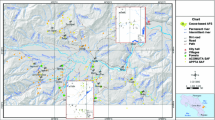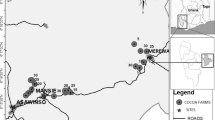Abstract
In southern Bahia, Brazil, cabrucas are the traditional agroforests in which cacao trees are planted under thinned-out native forests. To analyze the role of cabrucas in tree species conservation, we inventoried the non-cocoa trees in 1.0 ha plots of cabruca in 16 cocoa farms and compared our results with a similar survey undertaken in the early 1960s in the same region to analyze the long term changes. We also interviewed 160 cocoa farmers to investigate their preferences for species and the main practices used in managing shade trees. The cabrucas showed high levels of tree diversity for an agroforestry system (Shannon index ranging from 2.21 to 3.52) and also high variation in structure and composition among the different farms. Forest specialist trees accounted for most species (63.9%) in the survey and were among the species most preferred by the farmers, although we found evidence that some of these trees are gradually being replaced by other species. Our results indicate that cabrucas are poor substitutes for undisturbed forests in terms of tree species richness, but their presence in human-altered landscapes is of utmost importance to the conservation of forest tree species as they increase overall heterogeneity and may serve as ecological corridors, additional habitats, and buffer zones.





Similar content being viewed by others
Abbreviations
- CEPLAC:
-
Executive Committee for Cocoa Farming Plan
- CEPEC:
-
Cocoa Research Center
- DBH:
-
Diameter at breast height
- IV:
-
Importance value
- UESC:
-
State University of Santa Cruz
References
Alger K, Caldas M (1994) The declining cocoa economy and the Atlantic Forest of Southern Bahia, Brazil: conservation attitudes of cocoa planters. Environmentalist 14:107–119. doi:10.1007/BF01901304
Alvim P de T, Pereira CP (1965) Sombra e espaçamento nas plantações de cacau no Estado da Bahia. In: Relatório Anual do CEPEC 1964. CEPLAC, Ilhéus, pp. 18–19
Asase A, Tetteh DA (2010) The role of complex agroforestry systems in the conservation of forest tree diversity and structure in southeastern Ghana. Agrofor Syst 79:355–368. doi:10.1007/s10457-010-9311-1
Bhagwat SA, Willis KJ, Birks HJB et al (2008) Agroforestry: a refuge for tropical biodiversity. Trends Ecol Evol 23:261–267. doi:10.1016/j.tree.2008.10.005
Budowski G (1965) Distribution of tropical American rainforest species in the light of successional processes. Turrialba 15:40–42
Cassano CR, Schroth G, Faria D et al (2009) Landscape and farm scale management to enhance biodiversity conservation in the cocoa producing region of southern Bahia, Brazil. Biodivers Conserv 18:577–603. doi:10.1007/s10531-008-9526-x
Curtis JT, McIntosh RP (1951) An upland forest continuum in the prairie-forest border region of Wisconsin. Ecology 32:476–496. doi:10.2307/1931725
Delabie JHC, Jahyny B, Nascimento IC et al (2007) Contribution of cocoa plantations to the conservation of native ants (Insecta: Hymenoptera: Formicidae) with a special emphasis on the Atlantic Forest fauna of southern Bahia, Brazil. Biodivers Conserv 16:2359–2384. doi:10.1007/s10531-007-9190-6
Faria D, Laps RR, Baumgarten J et al (2006) Bat and bird assemblages from forests and shade cacao plantations in two contrasting landscapes in the Atlantic rainforest of southern Bahia, Brazil. Biodivers Conserv 15:587–612. doi:10.1007/s10531-005-2089-1
Faria D, Paciencia MLB, Dixo M et al (2007) Ferns, frogs, lizards, birds and bats in forest fragments and shade cacao plantations in two contrasting landscapes in the Atlantic forest, Brazil. Biodivers Conserv 16:2335–2357. doi:10.1007/s10531-007-9189-z
Fundação SOS Mata Atlântica, Instituto Nacional de Pesquisas Espaciais (2008) Atlas dos remanescentes florestais da Mata Atlântica período 2000–2005. Fundação SOS Mata Atlântica/INPE, São Paulo
García-Fernández C, Casado MA, Pérez MR (2003) Benzoin gardens in North Sumatra, Indonesia: effects of management on tree diversity. Conserv Biol 17(3):829–836. doi:10.1046/j.1523-1739.2003.01487.x
Geist HJ, Lambin EF (2002) Proximate causes and underlying driving forces of tropical deforestation. Bioscience 52:143–150. doi:10.1641/0006-3568(2002)052[0143:PCAUDF]2.0.CO;2
Gordon C, Manson R, Sundberg J et al (2007) Biodiversity, profitability, and vegetation structure in a Mexican coffee agroecosystem. Agric Ecosyst Environ 118:256–266. doi:10.1016/j.agee.2006.05.023
Hervé BDB, Vidal S (2008) Plant biodiversity and vegetation structure in traditional cocoa forest gardens in southern Cameroon under different management. Biodivers Conserv 17:1821–1835. doi:10.1007/s10531-007-9276-1
Johns ND (1999) Conservation in Brazil’s chocolate forest: the unlikely persistence of the traditional cocoa agroecosystem. Environ Manage 23:31–47. doi:10.1007/s002679900166
Jose S (2009) Agroforestry for ecosystem services and environmental benefits: an overview. Agrofor Syst 76:1–10. doi:10.1007/s10457-009-9229-7
Leakey RRB, Tchoundjeu Z (2001) Diversification of tree crops: domestication of companion crops for poverty reduction and environmental services. Expl Agric 37:279–296. doi:10.1017/S0014479701003015
Looy TV, Carrero GO, Mathijs E et al (2008) Underutilized agroforestry food products in Amazonas (Venezuela): a market chain analysis. Agrofor Syst 74:127–141. doi:10.1007/s10457-008-9110-0
López-Gómez AM, Williams-Linera G, Manson RH (2008) Tree species diversity and vegetation structure in shade coffee farms in Veracruz, Mexico. Agric Ecosyst Environ 124:160–172. doi:10.1016/j.agee.2007.09.008
Magurran AE (1988) Ecological diversity and its measurements. Croom Helm, London
Martini AMZ, Fiaschi P, Amorim AMA et al (2007) A hot-point within a hot-spot: a high diversity site in Brazil’s Atlantic Forest. Biodivers Conserv 6(3111–3128):3128. doi:10.1007/s10531-007-9166-6
Méndez VE, Shapiro EN, Gilbert GS (2009) Cooperative management and its effects on shade tree diversity, soil properties and ecosystem services of coffee plantations in western El Salvador. Agrofor Syst 76:111–126. doi:10.1007/s10457-009-9220-3
Mori SA, Boom BM, Carvalho AMV et al (1983) Southern Bahian moist forests. Bot Rev 49:155–232. doi:10.1007/BF02861011
Mueller-Dumbois D, Ellenberg H (1974) Aims and methods of vegetation ecology. Wiley, New York
Myers N, Mittermeier RA, Mittermeier CG et al (2000) Biodiversity hotspots for conservation priorities. Nature 403:853–858. doi:10.1038/35002501
Oke DO, Odebiyi KA (2007) Traditional cocoa-based agroforestry and forest species conservation in Ondo State, Nigeria. Agric Ecosyst Environ 122:305–311. doi:10.1016/j.agee.2007.01.022
Pardini R, Faria D, Accacio GM et al (2009) The challenge of maintaining Atlantic forest biodiversity: a multi-taxa conservation assessment of specialist and generalist species in an agro-forestry mosaic in southern Bahia. Biol Conserv 142:1178–1190. doi:10.1016/j.biocon.2009.02.010
Perfecto I, Vandermeer J (2008) Biodiversity conservation in tropical agroecosytems: a new conservation paradigm. Ann N Y Acad Sci 1134:173–200. doi:101196/annals.1439.011
Rice RA, Greenberg R (2000) Cacao cultivation and the conservation of biological diversity. Ambio 29:167–173. doi:10.1579/0044-7447-29.3.167
Rolim SG, Chiarello AG (2004) Slow death of Atlantic forest trees in cocoa agroforestry in southeastern Brazil. Biodivers Conserv 13:2679–2694. doi:10.1007/s10531-004-2142-5
Ruf F, Schroth G (2004) Chocolate forests and monocultures: a historical review of cocoa growing and its conflicting role in tropical deforestation and forest conservation. In: Schroth G, da Fonseca GAB, Harvey CA et al (eds) Agroforestry and biodiversity conservation in tropical landscapes. Island Press, Washington, pp 107–134
Saatchi S, Agosti D, Alger K et al (2001) Examining fragmentation and loss of primary forest in the southern Bahian Atlantic Forest of Brazil with radar imagery. Conserv Biol 15:867–875. doi:10.1046/j.1523-1739.2001.015004867.x
Sambuichi RHR (2002) Fitossociologia e diversidade de espécies arbóreas em cabruca (Mata Atlântica raleada sobre plantação de cacau) na região sul da Bahia, Brasil. Acta Bot Bras 16:89–101. doi:10.1590/S0102-33062002000100011
Sambuichi RHR (2006) Estrutura e dinâmica do componente arbóreo em área de cabruca na região cacaueira do sul da Bahia, Brasil. Acta Bot Bras 20:943–954. doi:10.1590/S0102-33062006000400018
Sambuichi RHR, Haridasan M (2007) Recovery of species richness and conservation of native Atlantic forest trees in the cacao plantations of southern Bahia in Brazil. Biodivers Conserv 16:3681–3701. doi:10.1007/s10531-006-9017-x
Sambuichi RHR, de Oliveira RM, Mariano Neto E et al (2008) Conservation status of ten endemic trees from the Atlantic Forest in the south of Bahia—Brazil. Nat Conserv 6:208–225
Schroth G, Lehmann J, Rodrigues MRL et al (2001) Plant–soil interactions in multistrata agroforestry in the humid tropics. Agrofor Syst 53:85–102. doi:10.1023/A:1013360000633
Schroth G, Harvey CA, Vincent G (2004) Complex agroforests: their structure, diversity and potential role in landscape conservation. In: Schroth G, da Fonseca GAB, Harvey CA et al (eds) Agroforestry and biodiversity conservation in tropical landscapes. Island Press, Washington, pp 227–260
Sonwa DJ, Nkongmeneck BA, Weise SF et al (2007) Diversity of plants in cocoa agroforests in the humid forest zone of Southern Cameroon. Biodivers Conserv 16:2385–2400. doi:10.1007/s10531-007-9187-1
Sparovek G, Berndes G, Klug ILF et al (2010) Brazilian agriculture and environmental legislation: status and future challenges. Environ Sci Technol 44:6046–6053. doi:10.1021/es1007824
Steffan-Dewenter I, Kessler M, Barkmann J et al (2007) Tradeoffs between income, biodiversity, and ecosystem functioning during tropical rainforest conversion and agroforestry intensification. Proc Natl Acad Sci USA 104:4973–4978. doi:10.1073/pnas.0608409104
Thomas WW, de Carvalho AMV, Amorim AMA et al (1998) Plant endemism in two forests in southern Bahia, Brazil. Biodivers Conserv 7:311–322. doi:10.1023/A:1008825627656
Thomas WW, de Carvalho AMV, Amorim AMA et al (2008) Diversity of woody plants in the Atlantic coastal forest of southern Bahia, Brazil. In: Thomas WW (ed) The Atlantic coastal forest of northeastern Brazil. The York Botanical Garden Press, New York, pp 21–66
Vandermeer J, Perfecto I (2007) The agricultural matrix and a future paradigm for conservation. Conserv Biol 21:274–277. doi:10.1111/j.1523-1739.2006.00582.x
Wade ASI, Asase A, Hadley P et al (2010) Management strategies for maximizing carbon storage and tree species diversity in cocoa-growing landscapes. Agric Ecosyst Environ 138:324–334. doi:10.1016/j.agee.2010.06.007
Acknowledgments
We are thankful to the Dutch Buffer Stock Fund (Dutch Ministry of Economic Affairs, Agriculture and Innovation), the Instituto Cabruca, and the Universidade Estadual de Santa Cruz for their financial support; the CEPEC/CEPLAC and HUESC herbaria for help in identifying the tree species; and to all those who collaborated with this project. We thank Dr. G. Schroth and Dr. C.D. Foy for their comments on an earlier version of this paper.
Author information
Authors and Affiliations
Corresponding author
Electronic supplementary material
Below is the link to the electronic supplementary material.
Rights and permissions
About this article
Cite this article
Sambuichi, R.H.R., Vidal, D.B., Piasentin, F.B. et al. Cabruca agroforests in southern Bahia, Brazil: tree component, management practices and tree species conservation. Biodivers Conserv 21, 1055–1077 (2012). https://doi.org/10.1007/s10531-012-0240-3
Received:
Accepted:
Published:
Issue Date:
DOI: https://doi.org/10.1007/s10531-012-0240-3




